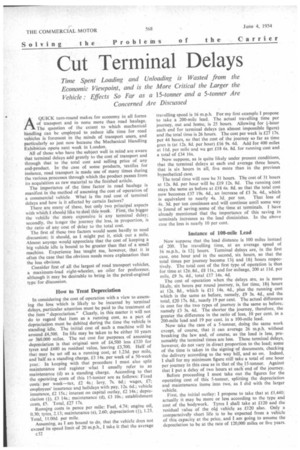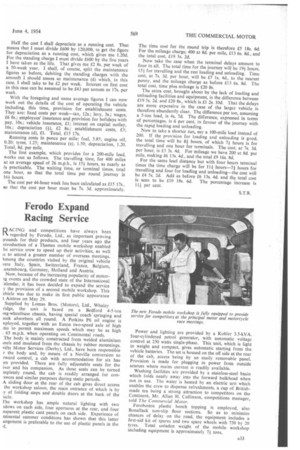Cut Terminal Delays
Page 70

Page 75

If you've noticed an error in this article please click here to report it so we can fix it.
Time Spent Loading and Unloading is Wasted from the Economic Viewpoint, and is the More Critical the Larger the Vehicle : Effects So Far as a 15-tonner and a 5-tonner Are Concerned Are Discussed
AQUICK turn-round makes for economy in all forms of transport and in none more than road haulage. The question of the extent to which mechanical handling can be employed to reduce idle time for road vehicles is foremost in the minds of transport users, and particularly so just now because the Mechanical Handling Exhibition opens next week in London.
All of those who have the subject well in mind are aware that terminal delays add greatly to the cost of transport and through that to the total cost and selling price of any end-product. In the case of some products, textiles for instance, road transport is made use of many times during the various processes through which the product passes from its acquisition as raw material to the finished article.
The importance of the time factor in road haulage is manifest in the method of assessing the cost of operation of a commercial vehicle What is the real cost of terminal delays and how is it affected by certain factors?
There are many of these, but only two principal aspects with which I should like to deal this week. First, the bigger the vehicle the more expensive is any terminal delay; secondly, the longer the journey the less, in proportion, is the ratio of any cost of delay to the total cost.
The first of these two factors would seem hardly to need discussion; it should, as I might put it, stick out a mile. Almost anyone would appreciate that the cost of keeping a big vehicle idle is bound to be greater than that of a small machine. Experience has taught me, however, that it is often the case that the obvious needs more explanation than the less obvious.
Consider first of all the largest of road transport vehicles, a maximum-load eight-wheeler, an oiler for preference, although it may be desirable to bring in the petrol-engined type for discussion.
How to Treat Depreciation In considering the cost of operation with a view to assessing the loss which is likely to be incurred by terminal delays, particular attention must be paid to the treatment of the item "depreciation." Clearly, in this matter it will not do to regard that item as a running cost, as a part of depreciation must be debited during the time the vehicle is standing idle. The initial cost of such a machine will be around £4,500. Its life may be taken to be either 10 years or 360.000 miles. The net cost for purposes of assessing depreciation is that original sum of £4,500 less £320 for tyres and £480 as residual value, leaving £3,700. Half of that may be set off as a running cost, at 1.23d. per mile, and half as a standing charge, £3 14s. per week of a 50-week year. In keeping with that procedure 1 must also split maintenance and register what I usually refer to as maintenance (d) as a standing charge. According to that the operating costs of this 15-toriner are as follows: Fixed costs per week-tax, £2 4s.; levy, 7s. 6d.; wages, £7; employees' insurance and holidays with pay, 12s. 6d.; vehicle insurance, £2 15s.; interest on capital outlay, £2 14s.; depreciation (1), £3 14s.; maintenance (d), £3 10s.; establishment costs, £5. Total, £27 17s.
Running costs in pence per mite: Fuel, 4.74; engine oil, 0.30; tyres, 2.13; maintenance (e), 2.60; depreciation (3), 1.23. Total, 11.00d. per mile. Assuming, as I am bound to do, that the vehicle does not exceed its speed limit of 20 m.p.h., I take it that the average c32 travelling speed is 16 m.p.h. For my first example I propose to take a 200-mile lead. The actual travelling time per journey, out and home, is 25 hours. Allowing for 3-hour each end for terminal delays (an almost impossible figure) and the total time is 26 hours. The cost per week is £27 17s. per 44 hours, so that the cost of the journey so far as time goes is (at 12s. 8d. per hour) £16 9s. 4d. Add for 400 miles at 1Id, per mile and we get £18 6s. 8d. for running cost and a total of £34 16s.
Now suppose, as is quite likely under present conditions, that the terminal delays at each end average three hours, that is six hours in all, five more than in the previous hypothetical case.
The total time will now be 31 hours. The cost of 31 hours at 12s. 8d. per hour will be £19 12s. 8d. The running cost stays the same as before at £18 6s. 8d. so that the total cost now becomes £37 19s. 44., an increase of £3 3s. 44., which
is equivalent to nearly 4s. 3d. per ton. That loss of 4s. 34:I. per ton continues and will continue until some way is found of saving some of the time at terminals. I have already mentioned that the importance of this saving in terminals increases as the lead diminishes. In the above case the loss is nearly 10 per cent.
Instance of 100-mile Lead Now suppose that the lead distance is 100 miles instead of 200. The travelling time, at an average speed of 16 m.p.h., is 121 hours. Terminal delays are, in the first case, one hour and in the second, six hours, so that the total times per journey become 131 and 18+ hours respectively. The total cost of the first type of operation is thus for time at 12& 84., £8 I Is., and for mileage, 200 at Ild, per mile, £9 3s. 4d., total £17 14s. 44.
The cost of operation when the delays are, as is more likely, six hours per round journey, is, for time, 18+ hours at 12s. 8d., which is £11 14s. 44., plus the running cost which is the same as before, namely, £9 3s. 4d., and the total, £20 17s. 8d., nearly 19 per cent. The actual difference in cost for the two types of journey is the same as before, namely E3 3s. 4d. The shorter the journey, therefore, the greater the difference in the ratio of loss, 10 per cent, in a 200-mile lead and 19 per cent, in a 100-mile lead.
Now take the case of a 5-tonner, doing the same work except, of course, that it can average 26 m.p.h. without breaking the law and, of course, as the load is less, presumably the terminal times are less These terminal delays, however, do not vary in direct proportion to the load; some of the time is taken in the signing of documents, checking the delivery according to the way bill, and so on. Indeed, I shall for my minimum figure still take a total of one hour per journey in this case as in that of the 15-tonner. Against that I put a delay of two hours at each end of the journey.
Before proceeding I must take out the figures for the operating cost of this 5-tonner, splitting the depreciation and maintenance items into two, as I did with the larger vehicle.
First, the initial outlay: I propose to take that at £1,440; actually it may be more or less according to the type and cost of the bodywork. Tyres I shall take at £120 and the residual value of the old vehicle as £120 also. Only a comparatively short life is to be expected from a vehicle of this capacity at the price, and I am going to assume the depreciation to be at the rate of 120,000 miles or five years.
Half the cost I shall depreciate as a running cost. That means that I must divide £600 by 120,000, to get the figure for depreciation as a running cost, which gives me 1.20d. For the standing charge I must divide £600 by the five years I have taken as the life. That gives me £2 8s, per week of a 50-week year. I shall, of course, split the maintenance figures as before, debiting the standing charges with the amouttt I should assess as maintenance (d) which, in this case, I shall take to be £2 per week. Interest on first cost in this case can be assumed to be £43 per annum or 17s. per week.
With the foregoing and some average figures I can now work out the details of the cost of operating the vehicle including, this time, provision for establishment costs. They are fixed costs per week-tax, 12s.; levy, 3s.; wages, £6 8s.; employees' insurance and provision for holidays with pay, 10s.; vehicle insurance, £1; interest on capital outlay, 16s.; depreciation (4), £2 8s.; establishment costs, £3; maintenance (d), £1, Total, £15 17s.
Running costs in pence per mile: fuel, 3.85; engine oil, 0.20; tyres, 1.25; maintenance (e), 1.50; depreciation, 1.20. Total, 8d. per mile.
The first example, which provides for a 200-mile lead, works out as follows. The travelling time, for 400 miles at an average speed of 26 m.p.h., is 151 hours, as nearly as is practicable. The waiting time, or terminal times, total one hour, so that the total time per round journey is 164 hours.
The cost per 44-hour week has been calculated as £15 17s.. so that the cost per hour must be 7s. 3d. approximately. The time cost for the round trip is therefore f5 18s. 6d. For the mileage charge, 400 at 8d. per mile, £13 6s. 8d., and the total cost, £19 5s. 2d.
Now take the case when the terminal delays amount to four in all. The total time for the journey will be 194 hours, 159 for travelling and the rest loading and unloading. Time cost, at 7s. 3d. per hour, will be £7 Is. 4d., to the nearest penny, and the mileage charge as before £13 6s. 8d. The total cost, time plus mileage is £20 85.
The extra cost, brought about by the lack of loading and unloading facilities and equipment, is the difference between £19 5s. 2d. and £20 8s., which is 11 2s. 10d. That the delays are more expensive in the case of the larger vehicle is therefore abundantly clear. The difference per ton, assuming a 5-ton load, is 4s. 7d. The difference, expressed in terms of percentages, is 6 per cent, in favour of the journey with the rapid loading and unloading.
Now to take a shorter run, say a 100-mile lead instead of 200. If the provision for loading and unloading is good, the total time will be 84 hours, of which 71 hours is for travelling and one hour for terminals. The cost, at 7s. 3d. per hour, is £3 3s. 4d. For mileage we have 200 at 8d. per mile, making £6 13s. 4d., and the total £9 16s. 8d.
For the same lead distance but with four hours terminal times the time charge will be for 114 hours-79 hours for travelling and four for loading and unloading-the cost will be £4 5s. 2d. Add as before £6 13s. 4d. and the total cost
is seen to be £10 I8s. 6d. The percentage increase is 111 per cent.
S.T.R.












































































































